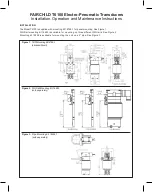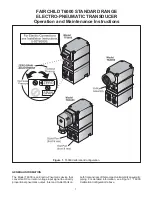
SECTION 4
CIRCUIT DESCRIPTION
4 - 1
4-1 RECEIVER CIRCUITS
4-1-1 RF SWITCHING CIRCUIT
(FILTER AND MAIN UNITS)
The RF switching circuit leads receive signals to bandpass
filters from the antenna connector while receiving. While
transmitting, this circuit leads signals from the RF power
amplifier to the antenna connector. This circuit includes a 20
dB RF attenuator circuit to prevent distortion from very
strong signals.
RF signals from the antenna connector pass through the
transmit/receive switching relay (RL13), and low-pass filter
(L14, C14–C16), and are then applied to the MAIN unit via
J3 (MAIN unit; J701).
The signals from the FILTER unit are either bypassed or are
attenuated at the 20 dB attenuator (D701, R703). The sig-
nals are then applied to RF filters.
4-1-2 RF BANDPASS FILTER CIRCUIT
(MAIN UNIT)
RF bandpass filters pass only the desired band signals and
suppress any undesired band signals.
The RF circuit has 7 RF bandpass filters (BPF) for signals
above 1.6 MHz and 1 low-pass filter (LPF) for signals and
suppress any undesired band signals.
(1) 0.03–1.6 MHz
The signals pass through the low-pass filter (L821, L822,
C822–C824) to suppress unwanted frequencies. The fil-
tered signals are bypassed a pre-amplifier by a BPF control
signal (B0) and preamp control signal (PROF), and are then
applied to the 1st mixer circuit (Q1101–Q1104).
(2) 1.6–2.0 MHz
The signals pass through a bandpass filter (L831–L833,
L835, L836, C831–C834, C837–C840) to suppress unwant-
ed frequencies. The filtered signals are then applied to the
pre-amplifier circuit.
(3) 2.0–30.0 MHz
The signals pass through a high pass filter (L811–L814,
C811–C817) to suppress excessively strong signals below
2.0 MHz, such as from broadcasting stations. The filtered
signals are applied to a low-pass filter and one of 5 band-
pass filters depending on their frequencies and are then
applied to the pre-amplifier circuit.
4-1-3 PRE-AMPLIFIER CIRCUIT (MAIN UNIT)
The pre-amplifier circuit uses two 2SK2171s to obtain 10 dB
of gain over a wideband frequency range. When the pream-
plifier is turned ON, the signals above 1.6 MHz are applied
to the pre-amplifier circuit.
Q1401 and Q1402 are connected in parallel to easily match
the impedance to 50
Ω
. IC3003 (pins 11, 12) switches the
signals from a bandpass filter, either to be bypassed, or to
be applied to the pre-amplifier, depending on the [PREAMP]
switch condition.
Amplified or bypassed signals are applied to the 1st mixer
circuit (Q1102–Q1104)
4-1-4 1ST MIXER CIRCUIT (MAIN UNIT)
The 1st mixer circuit mixes the receive signals with the 1st
LO signal to convert the receive signal frequencies to a
64.455 MHz 1st IF signal.
• Used RF filter
Band
0.03–1.6 MHz
1.6–2 MHz
2–4 MHz
4–8 MHz
Band
8–11 MHz
11–15 MHz
15–22 MHz
22–30 MHz
Control
signal
B4
B5
B6
B7
Control
signal
B0
B1
B2
B3
Input
diode
D802
1
⁄
2
D802
1
⁄
2
D803
D810
Input
diode
D804
D811
D805
D812
• RECEIVER CONSTRUCTION
ANT
1st mixer
Q1101–Q1104
FI301A/B
BFO
2nd LO
1st LO
Crystal
filter
2nd mixer
D401
IC2001
64.455 MHz
SSB, CW, RTTY
Ceramic
BPF
455 kHz
Ceramic
BPF
AF
selector
AM
detector
to AF amplifier
SQL controll
AM
FI611
SSB-N,
CW-N,
RTTY-N
(OPTION)
Crystal
BPF
Summary of Contents for IC-718
Page 1: ...HF TRANCEIVER iC 718 iC 718 ...
Page 54: ...Count on us iC 718 ...








































